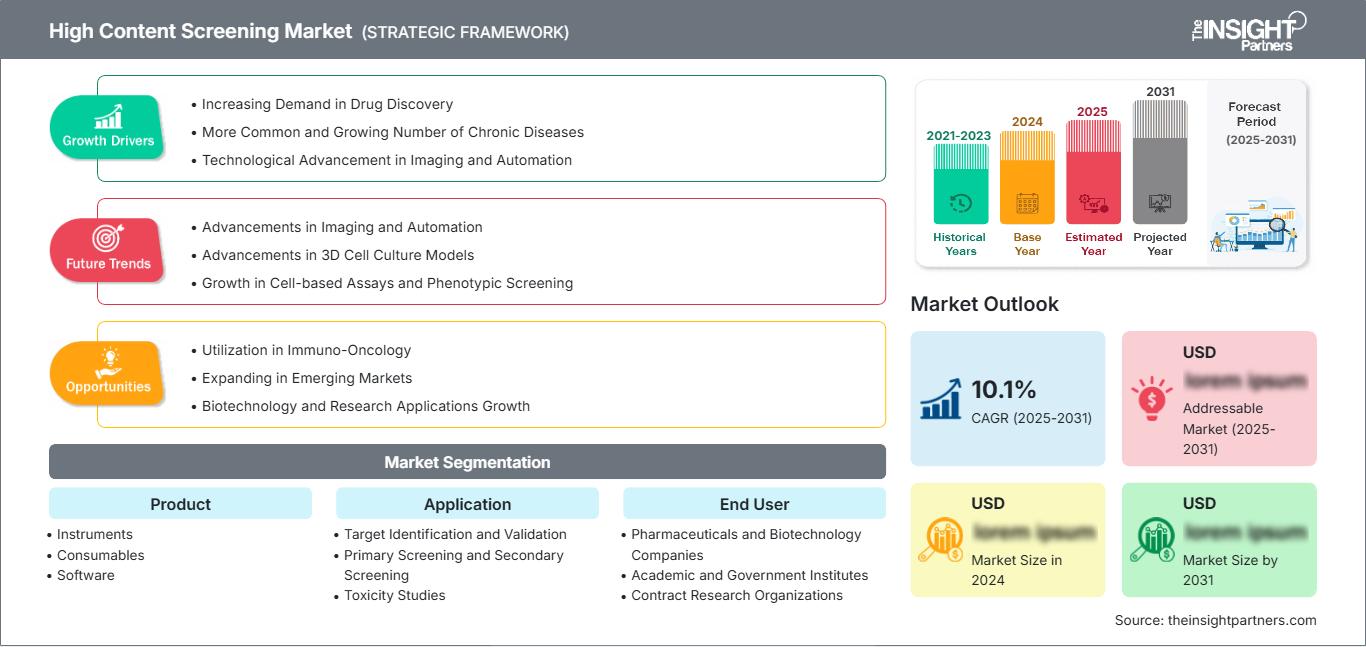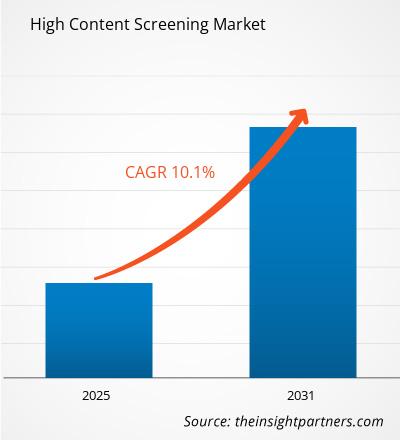The High Content Screening Market size is expected to reach US$ 2.93 billion by 2031. The market is anticipated to register a CAGR of 6.6% during 2025-2031.
The High Content Screening Market is categorized by product into Instruments, Consumables, Software, Services, and Accessories. It further breaks down by application, i.e., Target Identification and Validation, Primary and Secondary Screening, Toxicity Studies, Compounds, and Others, and end users, including Pharmaceuticals and Biotechnology Companies, Academic and Government Institutes, and Contract Research Organizations (CROs). Forecasts up to 2031 offer valuable insights into how high content screening market growth impacts productivity and customer satisfaction. The global analysis is broken down at the regional level and major countries. The market evaluation is presented in US$ for the above segmental analysis.
Purpose of the Report
The report High Content Screening Market by The Insight Partners aims to describe the present landscape and future growth, top driving factors, challenges, and opportunities. This will provide insights to various business stakeholders, such as:
- Technology Providers/Manufacturers: To understand the evolving market dynamics and know the potential growth opportunities, enabling them to make informed strategic decisions.
- Investors: To conduct a comprehensive trend analysis regarding the market growth rate, market financial projections, and opportunities that exist across the value chain.
- Regulatory bodies: To regulate policies and police activities in the market with the aim of minimizing abuse, preserving investor trust and confidence, and upholding the integrity and stability of the market.
High Content Screening Market Segmentation Product
- Instruments
- Consumables
- Software
- Services
- Accessories
Application
- Target Identification and Validation
- Primary Screening and Secondary Screening
- Toxicity Studies
- Compounds
End User
- Pharmaceuticals and Biotechnology Companies
- Academic and Government Institutes
- Contract Research Organizations
Geography
- North America
- Europe
- Asia-Pacific
- South and Central America
- Middle East and Africa
You will get customization on any report - free of charge - including parts of this report, or country-level analysis, Excel Data pack, as well as avail great offers and discounts for start-ups & universities
High Content Screening Market: Strategic Insights

-
Get Top Key Market Trends of this report.This FREE sample will include data analysis, ranging from market trends to estimates and forecasts.
High Content Screening Market Growth Drivers
- Increasing Demand in Drug Discovery: High-content screening (HCS) is a must-have technology for pharmaceutical research and development of drugs. In an increasingly globalized pharmaceutical sector looking for more efficient ways to screen for new drug candidates, HCS systems are increasingly used to screen many thousands of compounds and ascertain their effects on the cells.
- More Common and Growing Number of Chronic Diseases: The number of chronic diseases (cancer, diabetes, neurodegenerative diseases, etc) is increasing, which further necessitates the use of screening technologies for drug development and precision medicine. This fuels high-content screening in biomedical studies and clinical practice.
- Technological Advancement in Imaging and Automation: There have been significant advancements in imaging technologies, including automated microscopy, 3D imaging, and AI-driven image analysis. These are making a difference in the HCS process, enabling higher throughput, better accuracy, and greater resolution of cellular responses. Such improvements are driving the usage of HCS in all sorts of research and clinical applications due to the ability of screening large compound libraries at higher rates with greater precision.
High Content Screening Market Future Trends
- Advancements in Imaging and Automation: Automation in automated imaging, microplate readers, and data analytics has improved the precision and throughput of high-content screening solutions. HCS systems that are automated give consistency and efficiency to detect active compounds which drives the market.
- Advancements in 3D Cell Culture Models: There is a trend now toward using 3D cell culture systems in HCS. These systems allow for drug testing in an environment more physiologically relevant than traditional 2D cultures. These cultures are better representations of the complex human tissue, and that is reflected in the results for drug screening. This increasing demand is creating a huge market for advanced HCS platforms to support 3D cell culture systems and is a driver for market growth.
- Growth in Cell-based Assays and Phenotypic Screening: There is a growing preference for cell-based assays over traditional biochemical assays, as they provide more relevant biological information. Phenotypic screening, in particular, is gaining popularity due to its ability to identify the effects of compounds on cellular phenotypes without preconceived notions about the molecular targets. This trend is enhancing the utility of HCS in identifying novel drug candidates and improving disease models.
High Content Screening Market Opportunities
- Utilization in Immuno-Oncology: High-content screening is gaining adoption in immuno-oncology to find new cancer immunotherapies. This new research field could offer a major platform for HCS technologies to screen for immune-modulating drugs that would boost the cure of cancer.
- Expanding in Emerging Markets: With the global need for precision medicine rising, emerging markets offer enormous growth opportunities for the expansion of high-content screening technologies. As healthcare infrastructure and research facilities in these regions grow, adoption will likely accelerate.
- Biotechnology and Research Applications Growth: HCS is rapidly increasing in academic research and biotechnology fields, especially for cancer research, stem cell research, and genetic studies. HCS systems' ability to analyze complex biological phenomena and provide high-dimensional data helps in understanding cellular responses, gene expression, and disease mechanisms, thereby creating a space for HCS in research institutions, biotech firms, and contract research organizations that deal with advanced research and innovation.
The regional trends and factors influencing the High Content Screening Market throughout the forecast period have been thoroughly explained by the analysts at The Insight Partners. This section also discusses High Content Screening Market segments and geography across North America, Europe, Asia Pacific, Middle East and Africa, and South and Central America.
High Content Screening Market Report Scope
| Report Attribute | Details |
|---|---|
| Market size in 2024 | US$ XX Billion |
| Market Size by 2031 | US$ 2.93 billion |
| Global CAGR (2025 - 2031) | 6.6% |
| Historical Data | 2021-2023 |
| Forecast period | 2025-2031 |
| Segments Covered |
By Product
|
| Regions and Countries Covered |
North America
|
| Market leaders and key company profiles |
|
High Content Screening Market Players Density: Understanding Its Impact on Business Dynamics
The High Content Screening Market is growing rapidly, driven by increasing end-user demand due to factors such as evolving consumer preferences, technological advancements, and greater awareness of the product's benefits. As demand rises, businesses are expanding their offerings, innovating to meet consumer needs, and capitalizing on emerging trends, which further fuels market growth.

- Get the High Content Screening Market top key players overview
Key Selling Points
- Comprehensive Coverage: The report comprehensively covers the analysis of products, services, types, and end users of the High Content Screening Market, providing a holistic landscape.
- Expert Analysis: The report is compiled based on the in-depth understanding of industry experts and analysts.
- Up-to-date Information: The report assures business relevance due to its coverage of recent information and data trends.
- Customization Options: This report can be customized to cater to specific client requirements and suit the business strategies aptly.
The research report on the High Content Screening Market can, therefore, help spearhead the trail of decoding and understanding the industry scenario and growth prospects. Although there can be a few valid concerns, the overall benefits of this report tend to outweigh the disadvantages.
Frequently Asked Questions
What are the options available for the customization of this report?
What are the deliverable formats of the High Content Screening Market?
Which are leading players in High Content Screening Market?
What is the expected CAGR in High Content Screening Market?
What are the driving factors impacting High Content Screening Market?
What are the future trends of High Content Screening Market?
- Historical Analysis (2 Years), Base Year, Forecast (7 Years) with CAGR
- PEST and SWOT Analysis
- Market Size Value / Volume - Global, Regional, Country
- Industry and Competitive Landscape
- Excel Dataset
Recent Reports
Testimonials
Reason to Buy
- Informed Decision-Making
- Understanding Market Dynamics
- Competitive Analysis
- Identifying Emerging Markets
- Customer Insights
- Market Forecasts
- Risk Mitigation
- Boosting Operational Efficiency
- Strategic Planning
- Investment Justification
- Tracking Industry Innovations
- Aligning with Regulatory Trends





















 Get Free Sample For
Get Free Sample For